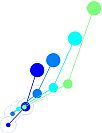Flexible decision making involves complex coordination of cognitive processes to decide, act, detect outcomes, and adapt response policies. Prefrontal cortical areas, in particular the midcingulate cortex (MCC) and lateral prefrontal cortex (LPFC) were shown to contribute differentially yet coherently to these processes: neural substrates to seek new information were identified in the LPFC and MCC and shifting between different behavioral strategies was identified in switches between different neural states in the MCC 2. This work aims to understand the neural basis of recruiting competing behavioral strategies. Macaques performed a stochastic 3-armed bandit task, while we simultaneously recorded population activity in LPFC and MCC. Critically, efficient harvesting of rewards required the integration of the history of rewards across trials. Behavioral analysis revealed that monkeys monitored their performance by computing Strategy value, a recency-weighted average of the previous outcomes, as shown by accurate prediction of strategy switching (between exploration and exploitation). We found that the Strategy value calculated from behavior can predict neural activity: linear decoding revealed strong neural correlates of the Strategy value in MCC populations, while this was largely absent from LPFC. By projecting the high-dimensional neural activity to the subspace defined by the decoder normal vector, we found that switching between strategies could be predicted by the activity in this low-dimensional subspace. Similar to the behavior, the neural correlate of the Strategy value reflected a weighted history of rewards and not only the most recent trial outcome. PCA analysis revealed that activity representing Strategy value emerges in MCC shortly before action selection, highlighting its role in decision making, and vanishes shortly after the feedback signal, indicating its role in the temporal integration of environmental information. Taken together, our analyses highlight the role of MCC neurons and their population dynamics during the decision making processes in higher-level cognition.

 PDF version
PDF version
